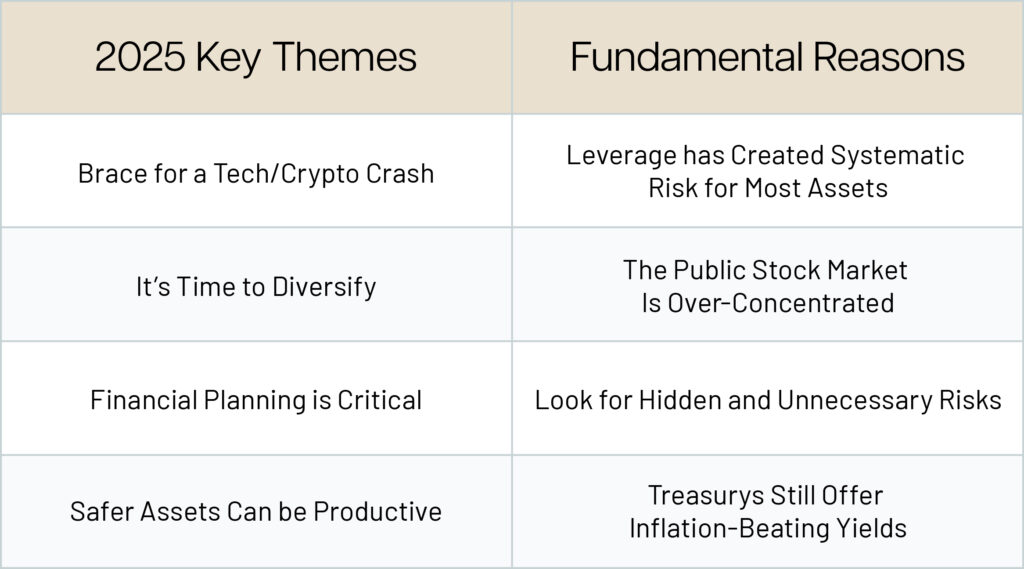If you have been consuming financial news this week, you will know the stock market has taken a bit of a plunge due to the tariffs announced on Wednesday afternoon. This comes on the heels of a volatile stock market in the first quarter. We wanted to give you BIP Wealth’s perspective on these recent events, although we are not ready to predict the final outcome.
What’s Driving Market Volatility Right Now?
We think the best way to understand what’s happening is to consider the actions of the four forces at play:
Force #1) Tariff Policy.
The current administration is using tariffs to re-write the economic relationship between the United States and other economies. For many years, other countries have imposed tariffs on U.S. goods and services that have been a bit lopsided against us. The U.S. has imposed its own tariffs on some imported goods in an effort to protect workers, while at the same time there have been numerous “free trade” agreements with favored nations. The history of tariffs goes back hundreds of years, but in more recent times the U.S. has emerged through it all as the world’s leading consumer economy of imported goods, while oftentimes struggling to export its own products while struggling with downward wage pressure at home. These newly announced tariffs are a powerful negotiating tool designed to leverage our consumer appetite and economic strength, but it is impossible to know where this will all settle out and when.
Force #2) Retaliation by other economies.
China has already announced retaliatory tariffs, although one could argue that the new U.S. tariffs were in retaliation for a massive trade imbalance that China protected. Over the next week we can expect to hear similar announcements from dozens of countries. This progression into a “trade war” could have a significant negative impact on the global economy, however many countries are expected to reach out to the Trump administration to negotiate. Some of these responses will likely be an effort to make the kind of “phenomenal offer” that President Trump has hinted he would be looking for. It is impossible to predict how this will end, but we will be watching to see the terms of the first few deals to see what it takes to settle these issues.
Force #3) The Federal Reserve.
For the past year, the Fed has enjoyed owning what is often called the “Fed Put.” This is borrowing terminology from the options markets, and refers to the idea that if the economy gets in trouble then the Fed can respond by lowering interest rates to prevent a recession. However, this only works when inflation is contained. Generally speaking, when interest rates are lowered it can cause inflation to rise; and with the Fed having bungled this quite a bit in the post-pandemic era they will likely be slow to move. Today President Donald Trump called on the Fed to lower overnight rates immediately. But tariffs on imported goods are expected to double the rate of inflation in 2025 to perhaps a rate of 5%, so any move by the Fed that could make that worse is quite the gamble. The Fed has a mandate to foster full employment, stable long term interest rates, and low inflation; but it does not have a mandate to do exactly what is being asked of it now. It is impossible to know how the Fed will respond at this point, although we will be listening intently to find out.
Force #4) The American electorate.
For the moment, the idea of tariffs seems to enjoy broad support among working Americans. Many families have watched in frustration for decades as furniture, textile, and manufacturing jobs have been offshored. Real wage growth in non-technical jobs has been slow, and it is correct to think that globalization has worsened the economic fortunes for many Americans. At the same time, we have enjoyed the benefits of lower prices on goods manufactured in low labor cost countries in Asia and elsewhere. Wall Street voices have been highly critical of the scope and pace of the new tariff policies this week, but that group is simply not the President’s constituency. If we fall into a recession, and American unemployment spikes, it will likely be happening around the globe even worse.
Understanding the situation through these four forces may not give you any comfort right now. But this is how we see it, and we’re watching events unfold just like you. Let’s keep in mind that a relief rally could be upon us at any time, and it could be a big mistake to assume that the pace of the sell-off will simply continue.
In our Annual Market Report earlier this year we suggested some steps you could take to prepare for this kind of uncertainty. Click the link below to check out Eric Cramer’s Webinar from Q1…
Our 4 Key Investment Themes for 2025
As a reminder, here are our 4 Key Themes for 2025 and what we’ve seen so far:

Brace for a Tech/Crypto Crash (Leverage has Created Systematic Risk for Most Assets)
Well, tech stocks did crash. We have strategies in place to help clients with large concentrations to mitigate risk.
It’s Time to Diversify (The Public Stock Market is Over-Concentrated)
We suggested that indexing would not be sufficient due to the concentration in public equities, and that using private credit in particular could be an effective way for many clients to possibly increase their expected return while lowering their expected risk.
Financial Planning is Critical (Look for Hidden and Unnecessary Risk)
We did our best to suggest that some clients may have more exposure to public equities than they “needed” to have. This was in addition to the other benefits of financial planning, such as risk mitigation through an insurance review.
Safer Assets Can be Productive (Treasurys Still Offer Inflation-Beating Yields)
We offer clients BIP Short-Term Tactical, which is our proprietary trading strategy providing an alternative to holding cash in banks. The primary goals of the strategy include achieving a rate of return higher than banks commonly offer, capital preservation, and liquidity, while mitigating risk.
While we can’t predict the future, we strongly suggest having a well-rounded financial plan. This is a great time to take a look at your particular situation and work with a BIP Personal Wealth Advisor so you can take advantage of all the tools we have at our disposal.
Thanks for reading, and please know that we will continue to update you as events unfold.
This post is provided for informational purposes only. Specific investments may not be suitable for all investors and no offer or recommendation of any investment or investing strategy is intended. The opinions in this commentary are as of the posting date and are subject to change. Information has been obtained from third-party sources we consider reliable, but we do not guarantee the facts cited are accurate or complete. This material is not intended to be relied upon as a forecast or investment advice regarding a particular investment or the markets in general, nor is it intended to predict or depict the performance of any investment. We may execute transactions in securities that may not be consistent with what is mentioned here. Investors should consult their financial advisor on the strategy best for them. Past performance is no guarantee of future results. All investments involve risks including loss of principal.

